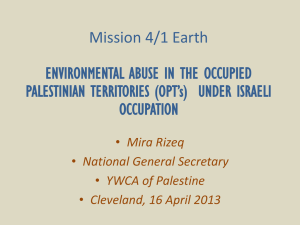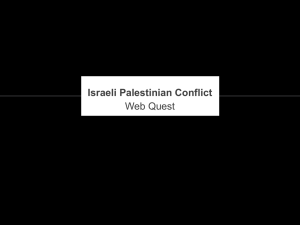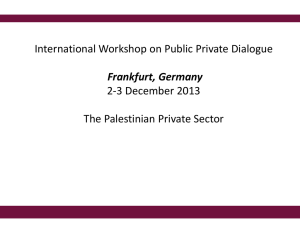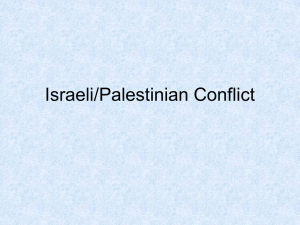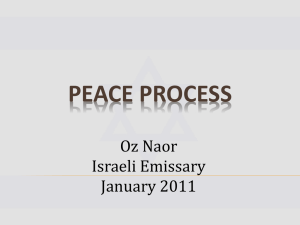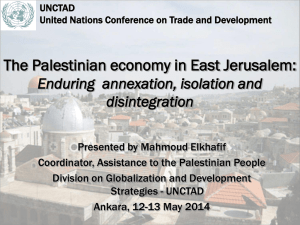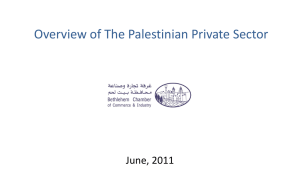Document
advertisement
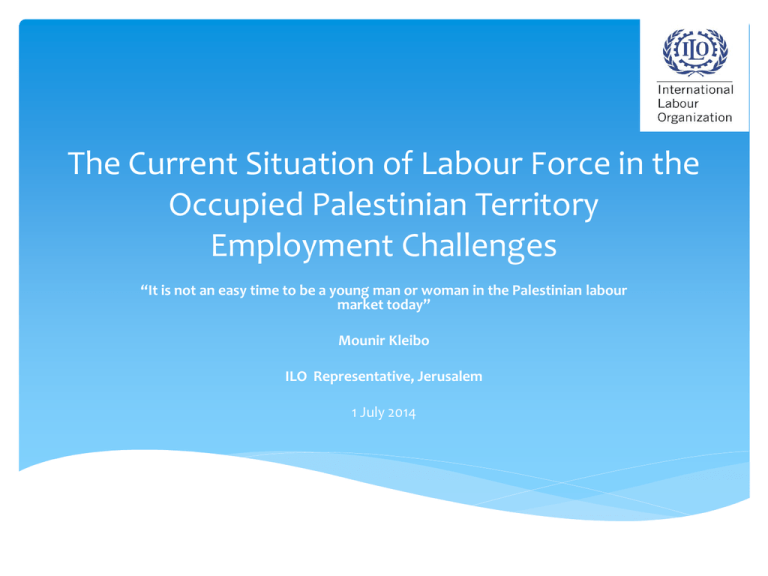
The Current Situation of Labour Force in the Occupied Palestinian Territory Employment Challenges “It is not an easy time to be a young man or woman in the Palestinian labour market today” Mounir Kleibo ILO Representative, Jerusalem 1 July 2014 Historical Background Settlements Settlements are essentially large housing projects built illegally by Israel on land confiscated from Palestinians within the West Bank and Jerusalem. These settlements are joined to each other and to Israel through "by-pass" roads, which are for the exclusive use of Israelis and which are also built on privately owned Palestinian land confiscated by the Israeli government. Settlement construction and expansion more than doubled during 2013. * Abu Gneim Forest – Abu Gneim Settlement The Separation Wall Length 709km 85% of the separation wall is within the West Bank itself, not along the Green Line Restrictions and more hardships to Palestinians Difficulties in reaching their fields Destruction of thousands of olive trees Restriction of movement between villages Overall Economic Situation in the OPT Real GDP growth only 2% in 2013 Decline in the productive sectors of agriculture and industry – 1/5 of the GDP in 2013 compared to over 1/3 in 1994 Agricultural productivity particularly low – Agriculture contributed 3.7% of the GDP and accounted for 10.5% of employment Service sector dominates the economy in terms of both GDP and employment The Labour Force participation in the OPT The labour force rate of persons aged 15 years and above was 46.3% The number of persons participating in the labour force in the OPT was about 1,253,600 in the 1st quarter 2014; about 812,200 in the West Bank and about 441,400 in Gaza Strip. The number of unemployed was increased from 301,200 in the 4th quarter 2013 to 328,000 in the 1st quarter 2014: the number increased in Gaza Strip from 159,600 in 4th quarter 2013 to 180,200 in 1st quarter 2014, also it increased in the West Bank from 141,600 to 147,800 in the same period. The unemployment rate in Gaza Strip increased from 38.5% in the 4th quarter 2013 to 40.8% in the 1st quarter 2014 while it was at the same level in the West Bank at 18.2% in the same period, and the unemployment rate for males in Palestine was 23.3% compared with 36.5% for females in the 1st quarter 2014. The highest unemployment rate in the 1st quarter 2014 was 43.0% among youth aged 20-24 years. The highest unemployment rates in the West Bank governorates was in Jerusalem with 21.4%. In Gaza Strip, the highest unemployment rate was in Khan Younis with 46.4%. The services sector was the biggest employer in the local market with 32.6% in the West Bank and 56.3% in Gaza Strip. The public sector employed 22.9% of those in employment: 40.5% in Gaza Strip and 15.9% in the West Bank. Situation of Palestinian Women in the Labour Force Women labor force participation aged 15 years and above during 1st qurter 2014 was 17.3 % About half of the Palestinian population are females Female participation in the LFis amongst the lowest in the world at and is much lower for women with higher education and university degrees. Gender-based stereotypes on women’s role and position in the workplace, few employment opportunities for women and jobs mainly Participation of men in LF are still four times higher than women Women, particularly those lacking skills hold menial positions with compensations that don’t meet minimum wage and no overtime work compensations. High levels of gender-based occupational segregation Female participation in the LFis amongst the lowest in the world at and is much lower for women with higher education and university degrees. Women’s informal work not full reflected in labour statistics Membership of women in trade unions and employers’ organizations low Youth Employment in the OPT Definition of youth While in other contexts, a youth is defined as a person aged between 15 and 24 (United Nations, for example), for the purpose of the SWTS and related reports, the upper age limit is 29 years of age. This recognizes the fact that some young people remain in education beyond the age of 24, and allows the opportunity to capture more information on the post-graduation employment experiences of young people. 70 % of the Palestinian population under the age of 30 49% of young men aged 15-24 participated in the labour force compared to 8.8% of young women Unemployment rate for young men was 36.9% while for women 64.7% Youth unemployment rates in Palestine are among the highest in the region, particularly for young women, and long-term unemployment affects more than half of unemployed youth. While unemployment may be higher among the better educated, the results clearly show that investing in education brings positive returns to youth in terms of wages and access to the “better” jobs. Youth Employment in the OPT The youth labour force participation rate is very low at 38.5 per cent and reflects a wide gender gap (61.8 per cent for young men compared to 15.6 per cent for young women). Forty-two (41.8) per cent of young males are working and only 7.1 per cent of young females. With a strong majority in paid employment, it appears that self-employment is not an attractive option for most youth Poor quality of employment is a concern that impact on the capacity of the youth (and the territory) to make the most of their economic potential. The youth labour market in the Occupied Palestinian Territory is profoundly influenced by gender issues. Recent School to Work Transition Survey 2014 Situation in Gaza Food insecurity 60% 80% of the population rely on humanitarian aid Unemployment rose due to the closure of the tunnel economy – 34.8% for men and 53.5% for women Youth unemployment in Gaza was 51.8% for young men and 86.3 for young women Despite positive developments in the official educational system, young Palestinians still face difficult labour market transitions. Unemployment among youth is a major national concern, but it is also important to consider the quality of work made available to the young population. Situation in Gaza Gaza productive capacity is diminished by restrictions on access to its agricultural land and fishing water in addition to restriction on imports 35% of Gaza’s agricultural land is a buffer zone Fishing limits were extended in March 2013 from 3 to 6 nautical miles ( still far from the 12 nautical miles negotiated in 2002 Bertini Agreement) Energy and water shortages one of the main problems in Gaza Gazans receive as little as 8 hours of electricity per day No fewer than 30 % of households only receive running water for 6-8 hours once every four day Over 90% of the water extracted from the Gaza aquifer is deemed unsafe for human consumption ( OCHA, 2013) Palestinian Workers in Israel Employment in Israel is regulated by a quota and permit system Minimum age to obtain a permit is 24 years old but you have to be married and have children By March 2014, the total quota of permits was 48,250 of which 45,007 were issued It is estimated that 35,000 Palestinians took work in Israel without a permit through unregulated channels Palestinian workers without permits are particularly vulnerable to exploitation and abusive practices Palestinian Workers in Israeli Settlements Working in Israeli settlements is not a choice but a necessity for Palestinian workers Palestinian men tend to work in construction and industrial sector while women work in agriculture or domestic work Many Palestinian workers in settlement endure abuse Women are particularly exposed to abusive practices by labour brokers including excessive fees or wage deduction and sexual violence Palestinian workers in settlement are exposed to occupational safety risks and hazardous conditions without adequate protection Challenges Facing Palestinian Workers working in Israel and in Israeli Settlements Israeli occupation of more than 60 per cent of West Bank and imposition of movement barriers make mobility of workers difficult within the territory. The Israeli wall erected in the territory has confiscated large parts of agricultural areas and natural resources in the West Bank. Border controls by the Palestinian National Authority and Israeli restrictions on the passage of tradable goods Challenges facing Palestinian workers working in Israel and in Israeli settlements Employment in Israel and Israeli settlements of the West Bank provide some jobs to Palestinian youth. However, this source of employment is restricted by Israeli closure on the OPT. Working conditions in Israel for young Palestinians have deteriorated, with many workers taking up informal jobs. Although they need official work permits from Israeli occupation authorities in West Bank, Palestinian workers find themselves obliged to stay in Israel due to closure policy over West Bank. Child and Persons with Disability as part of the Labour Force in the OPT In 2004, an estimated 3.1 per cent of Palestinian children aged 5-17 years of age were working children, 56.2 per cent being classified as child labourers. This figure has further increased to 4.1 per cent by 2014 and today, an estimated 32,000 children aged 10-17 work either as unpaid family workers (including 98 per cent of girls) or waged and self-employed workers. The majority of child labour in oPt is in agriculture - 38.5 per cent and this trend has been consistent throughout the years. Persons with disability (PWDs) face great impediments and obstacles for being integrated in the oPt labour market. Rate of unemployment among PWDs is 78% while rate of employment is only 22%. Most of employment opportunities are short term/project base and are linked with NGOs or international organizations. Women with disability suffer even more from obstacles concerning accessibility to the labour market. These obstacles are related to gender-based attitudes, traditions and customs,low wages, unequal opportunity, etc. Rate of unemployment among women with disability is 73%. Pictures of Child Labour in the OPT Challenges in the Labour Market in the occupied East Jerusalem: The Israeli authorities do not provide key services in the fields of education and employment for Palestinians in East Jerusalem, which severely impacts upon the educational system and fails to prepare students with skills that best fit labour market requirements. Part of the education and higher education system falls within the responsibility of the Israeli Ministry of Education and Municipality. It is subjected to serious negligence, low budgets, over crowding, lack of regular and vocational schools, and lack of classrooms, capacity and facilities. Students in East Jerusalem schools learn Hebrew as a third language along with Arabic and English, and at times they have to learn a fourth language if they are acquiring their education in private foreign schools (French or German). Graduates of the Arabic educational system under the Palestinian Ministry of Education (i.e. Waqf, governmental, UNRWA and private schools in East Jerusalem) do not learn or practice the Hebrew language, which in turn is a major constraint in facilitating their entering the Israeli labour market, which requires full fluency for day-to-day use. Many of the Palestinian youths in East Jerusalem attempt to acquire academic titles and vocational training in the West Bank, and even overseas in Arab or European countries or the United States of America. Some of the disturbing consequences for all this would be the migration or relocation (and thus loss) of those educated and cultured people – raised initially in East Jerusalem – to the West Bank or even abroad Challenges of Employment in East Jerusalem The enforcement of the strenuous check point procedure and permits to enter Jerusalem has resulted in excluding East Jerusalem from all The erection of the security wall surrounding East Jerusalem along 142 kilometers has caused direct losses to the economy in East Jerusalem. Reduction in consumer demand was a major factor in the closure of more than 280 stores in East Jerusalem over the last 15 years, 50 of them in the old city alone. The excessive cost and complex bureaucracy precluded Palestinian businessmen from establishing commercial projects in East Jerusalem. The dire public transport services in East Jerusalem pose another obstacle to any Palestinian working in West Jerusalem, for it only covers Palestinian populated areas and the commercial centre in the old city. Palestinian women in East Jerusalem are greatly affected by the declining socio-economic status, the lack of educational frameworks for herself and her children, and the scarcity of appropriate jobs. The rate of Palestinian women engaged in the labour market does not exceed 15%; the type of work they perform is usually within the fields of education and office functions in the private sector. Area C : More than half the land in the West Bank, much of it agricultural and resource rich, is inaccessible to Palestinians. Area C constitutes 61 percent of the West Bank and is the only contiguous land connecting 227 smaller separate and heavily residential areas. Unleashing the potential from that ‘restricted land and allowing Palestinians to put these resources to work, would provide whole new areas of economic activity and set the economy on the path to sustainable growth. Growth of approximately six percent annually is needed to absorb new entrants to the labor market, A vital economy is essential for citizen wellbeing, social stability and building confidence to underpin the challenging political negotiations. If businesses and farms were permitted to develop in Area C, this would add as much as 35 percent to the Palestinian GDP The loss to the Palestinian economy at about US$3.4 billion. World Bank 2014 Area C : More than half the land in the West Bank, much of it agricultural and resource rich, is inaccessible to Palestinians. Freeing economic activity in Area C would have a particularly high impact on the development of businesses in agriculture and Dead Sea minerals exploitation, stone mining and quarrying, construction, tourism, and telecommunications. Other sectors would be able to benefit from improvements in the quality and cost of infrastructure and increased demand for goods and services The volume of increased economic activity would greatly improve the PA’s fiscal position. It is estimated that government revenues would increase by US$800 million, which would cut the fiscal deficit by half, hence reduce the need for donor support, and reduce unemployment and poverty rate ILO in the OPT ILO has been supporting and continues to support women and youth empowerment in the oPt, through supporting the promotion and development of women-only cooperatives, introducing new vocational education training programmes for young people, and supporting entrepreneurship by offering know-how on business management and funding for business startups. وعلى هذه االرض ما يستحق الحياة :محمود درويش شكرا
